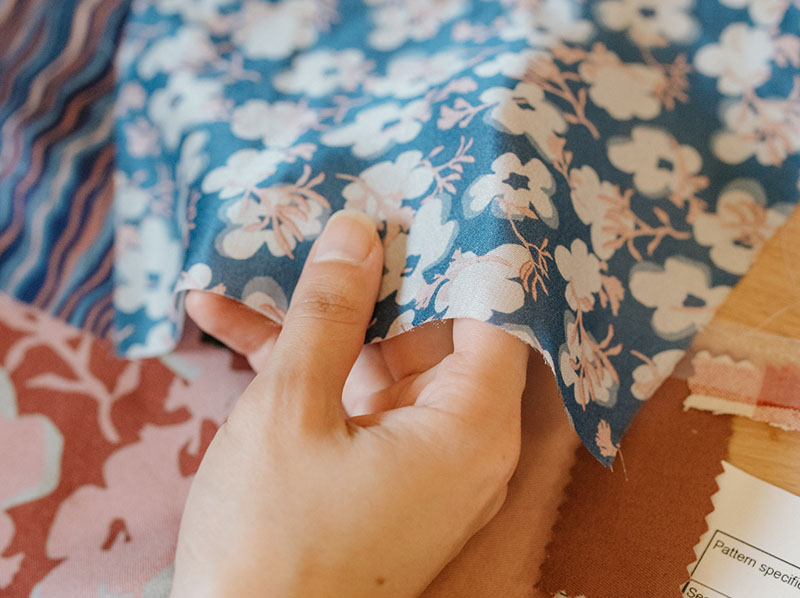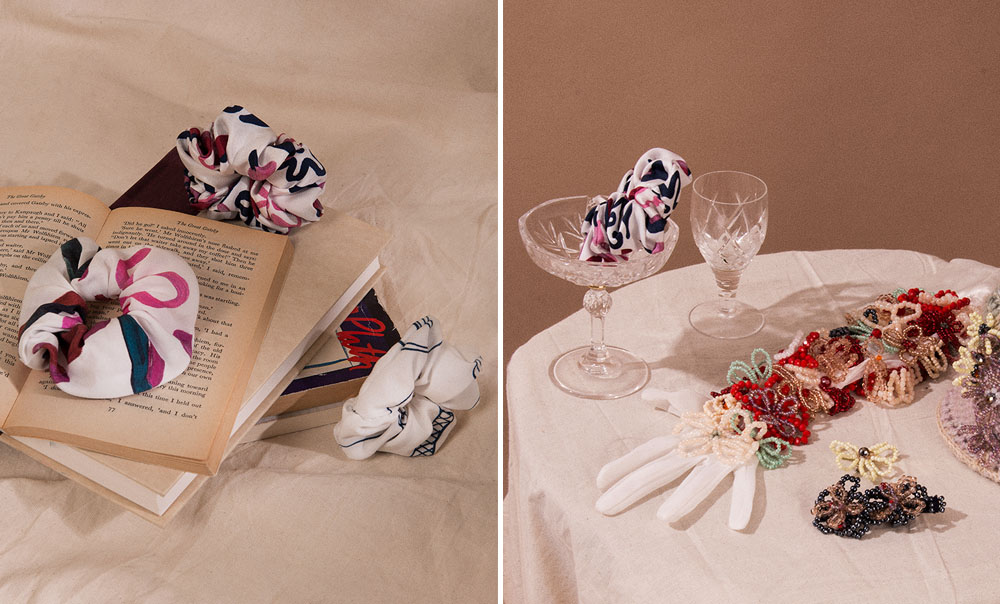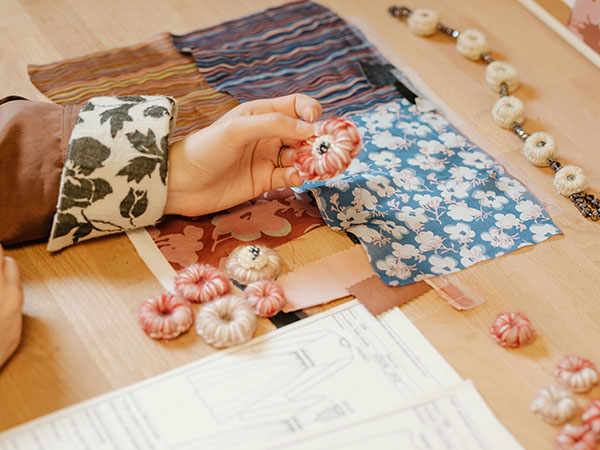

95% of all SABINNA garments are made out of natural fibers. Natural fibres are not only better for your skin, for us it’s also important to reduce the amount of microplastics that are going into the oceans whenever we wash our clothes. Here is a list of materials that we like to work with:
Organic cotton: In general, cotton is one of the most popular fabrics and accounts for more than half of all fiber needs across the globe. Both, regular and organic cotton are natural fibers and differ in the way they’re being harvested.
We us GOTS certified 100% organic cotton for our t-shirts and some of the clothes that have our signature prints.
Cotton: The regular cotton that you will find within our collections is deadstock cotton, that would normally go to landfill. We source our deadstock from factories in UK, this way we also reduce our carbon footprint, as we don’t have to fly in the rolls of fabrics.
What is the difference between regular and organic cotton?
Regular cotton is more in demand and is usually machine-picked to cope with the rush. Organic cotton is completely handpicked, which ensures that no fiber is damaged in the process. This ensures that these fibers don’t get weakened or broken, resulting in softer and more durable products. That’s also the reason why organic cotton is also softer than regular cotton because of the longer fibers.
Linen: Linen is a fabric made from the fibre of the flax plant. The fiber is very strong, absorbent and dries quicker than cotton. It also has natural heat and moisture-wicking properties, which make garments made of linen popular for their coolness and freshness in hot and humid weather.
(Tencel) Lyocell: Lyocell is a rayon which consists of cellulose fibers and is sourced from wood. It is manufactured from eucalyptus trees, which use 80% less water than cotton. These fibers are known for their natural comfort and can be combined with a variety of other textile fibers such as cotton, polyester and wool to enhance the aesthetic and functionality of fabrics. The fibers are certified as compostable and biodegradable, and thus can fully revert back to nature.
Silk: Silk is one of the oldest fibres known to humankind and is a natural protein fiber. It is known for its high tensile strength, shine and ability to bind chemical dyes and can therefore be made in amazing colours. Silk is produced by many insects but most commercial silk comes from caterpillars.
Bamboo: Bamboo fabric is a natural textile made from the pulp of bamboo grass. Bamboo is considered one of the most sustainable plants because it grows quickly and does not require chemicals or irrigation, and biodegrades more quickly than oil-based synthetics. It’s also an alternative to plastic, but is renewable and can be replenished at a fast rate.
Viscose: Viscose is a type of rayon. It’s a low-cost fabric, which is popular thanks to its myriad of qualities. As a manufactured regenerated cellulose fibre, it is neither truly natural (like cotton, wool or silk) nor truly synthetic (like nylon or polyester) – it falls somewhere in between. We use deadstock viscose for linings.
Wool:
There are different types of wools and as a consumer it’s not always easy to tell them apart. Our woven wools ( for trousers, dresses and coats) are deadstock fabrics. The wool for our knitwear is mostly organic wool and alpaca wool.
What different types if wool are there?
Sheep: Sheep’s wool is an incredibly complex type of fabric. It absorbs dye really well, which is why it’s known for its beautiful colours. It’s also an absorbent fiber, which is comfortable to wear in warm and cool climates. It’s incredibly versatile and replenishes itself each time the sheep is sheared and continues to grow throughout its lifetime.
Merino: Merino wool is a natural fiber grown by Merino sheep. It’s thinner and softer than regular wool, making it easy to wear next to skin. Merino wool is a natural, renewable fiber, meaning one sheep can grow four to five pounds of wool per year. It’s known for its softness, shine and breathability.
Alpaca: Alpaca wool can be either light or heavy depending on how it is spun, which makes it ideal for a number of different garments. Even though it is similar to sheep’s wool, alpaca wool is softer and more durable as well as warmer.
Mohair: Mohair wool is derived from the hair of the Angora goat. It is very common to find mohair that has been mixed with other fabrics as it adds to the elasticity, shine and durability of the garment. It also takes dye exceptionally well and is warm in winter due to its insulating properties.


At SABINNA we have different types of packaging, depending on the order you’ve placed with us. To wrap the items safely, we are using our customised tissue paper with this season’s signature SABINNA flower print. For small orders, we are using 100% compostable mailers, larger orders will be packed into recycled boxes.
The tissue paper and the mailers are designed by Noissue and are not only beautiful but also 100% sustainable. We were looking for packaging, that is leading in design, innovation and sustainability. That’s why our signature printed tissue paper was printed using soy-based ink and is completely acid-free and FSC certified. The mailers are made out of corn and are 100% compostable. Thanks to Noissue we can wrap our SABINNA products in high-quality packaging without harming the environment.


We always keep the waste of our production and try to reuse it to create something new and wonderful; whether that’s accessories such as handbags or scrunchies made of our leftover fabrics or to simply use it for the repair of our items.
Reducing waste is important to us, that’s why we decided that we want to offer our leftover fabrics to our customers as well. Are you a DIY fan? Do you love sewing and want to create your own pieces with our fabrics? We would love to share our unused textiles with you (free of charge!) all you need to do is cover the shipping costs. Simply drop us a line at offcuts@sabinna.com to give our unused fabrics a new home 🙂


Free repairing services
We believe in making the most out of your garment, which is why we offer free repairing services if your item needs fixing.
Whether you’ve noticed a hole in your garment, a missing button or a loose hemline, we’ll make sure to give your garment the love and care it deserves so you’re 100% satisfied again.
Just drop us an e-mail at aftercare@sabinna.com and we’ll make sure to take care of the rest.

A few little tricks on how to take care of your garment to prolong its life
This guide is meant to help you figure out how to wash and take good care of your clothes so they will last you a long time. There’s a couple of rules and things to remember when washing, drying and ironing your clothes:
Always separate your white garments from your colours and make sure you don’t mix different fabric types. This might be obvious to some but it will ensure that your clothes don’t suddenly change colour or size.
The more delicate the item, the better it is to wash it by hand. Always make sure to rinse the garment after letting it sit in the water to make sure there’s no detergent residue on them!
Here’s a general guide on how to properly wash your item by hand: Just fill your basin with cool or cold water to help protect the color and add a gentle detergent. Place the garment in the water, give it a stir, let it sit for a few minutes and rinse it out. Done!
The more delicate the fabric, the better it is to let it air dry.
We love air drying as well, because it’s safer for our environment, but no worries, we’ll still give you instructions on how to dry garments in your machine and won’t judge you for it 🙂
Ready to take good care of your clothes? Let’s go!
We always recommend following the instructions on the care label, but if it came loose or you can’t identify the instructions anymore, don’t worry! That’s what our guide is for 🙂
If that’s the case, the first step is identifying the fabric of your garment.
Linen: Linen can be easily washed in a machine or by hand. It needs to be washed in low temperatures, on a gentle machine cycle and with a mild detergent to protect the fibres. If you can freely adjust your machine cycle, chose a program with a long soak, a short wash, a rinse and a short spin.
Feel free to machine dry your linen clothes, as long as you stick to low temperatures. Remove them from the dryer when still slightly damp to avoid the linen becoming stiff, and hang or lie flat to finish off the drying process.
As for ironing, there is generally no need to iron linen fabrics, unless they have become really crushed. In that case, iron while the fabric is still damp. We recommend using a medium-hot iron on the steam setting.
Cotton: If the cotton garment is worn close to the body (such as underwear, socks and even towels), you should wash these items in hot water to remove bacteria. For any other cotton garments, warm or cold water is the best washing temperature to prevent shrinkage and stretching, particularly with organic cotton. Cooler water temperatures will also help prevent fading in bright or darker colors.
You can use the lowest dryer setting for cotton clothing, but hanging the items to air dry is the best way to maintain their shape and size.
The secret to quick and easy ironing of all cotton shirts is lots of steam and generally, cotton requires the highest heat setting.
Tencel: Tencel is a delicate fabric, therefore it’s best to wash it by hand with a gentle detergent. If washed in a machine, it’s important to use a gentle cycle and cold water.
It’s best to let the garment air dry but some Tencel fabrics can be put in the tumble dryer on a cool setting, just make sure to read the instructions on your care label.
If necessary, you can iron the item, however use a warm iron only, as too much direct heat may scorch the fabric. Tencel garments are generally wrinkle resistant, so they’re very easy to store.
Silk: Careful! Silk is incredibly delicate, so be careful to not use harsh detergents.
In general, it is best to wash silk garments in the sink. In some cases, you can wash them in the washing machine, however make sure to use a gentle and a short spin cycle.
Never wring your silk items and avoid putting them in the dryer!
To iron silk without damaging it, it’s crucial to use the lowest heat setting on your iron.
Bamboo: When washing, use a gentle wash cycle, cold water and a good detergent so the fabric maintains its suppleness. Sweaters and knitted accessories made from bamboo fibers should be hand washed to prevent stretching.
Clothes made from bamboo fabrics should be air dried; knitted bamboo sweaters should be dried flat to prevent stretching. High temperatures in a dryer can shrink bamboo clothing, however if quicker drying is needed, make sure to use the low heat cycle of the dryer and remove the item while still slightly damp.
As for ironing, keep it cool! Extremely high temperatures can scorch bamboo fibers, therefore use a dry iron (no steam) at a low setting, if necessary.
Viscose: Viscose clothing usually tends to be dry clean only because it has a low wet strength which can cause it to shrink or stretch if it becomes wet, so hand wash is preferred. However, some items can be washed in temperatures of up to 40° C.
It is not recommended to tumble dry viscose because it does not retain moisture, so the fabric dries very quickly anyway, which means there is no need for a dryer.
When ironing your garment, make sure to use a medium heat temperature setting on your iron.
Wool: Given that wool is a delicate fibre which is very absorbent, it can be prone to shrinking, misshaping or a change consistency if treated too roughly when washed.
Because wool is a natural, self-regulating fibre, it also does not actually need to be cleaned as frequently as other clothes.
Be sure to turn the garment inside out before you wash it, which will prolong the condition of it. Always use a cold water cycle, even warm water will cause wool to shrink.
Never tumble dry as the heat from the machine will shrink the garment!
If your wool garment is wrinkled, simply hang up the item, which will allow the fibers to relax and may eliminate the need for ironing.
It is highly recommended to use a cotton-based heavy cloth as a pressing mesh to iron your wool clothes effectively. All you need to do is place the pressing mesh between the iron surface and the wool garment for soaking the excess heat. Wool is a natural fabric that requires mild ironing. Choosing a too-hot-temperature setting could lead to discoloration and scorch marks!
If you’re still unsure about how to wash your SABINNA garment, don’t hesitate to e-mail us at aftercare@sabinna.com before you risk ruining your garment. 🙂



